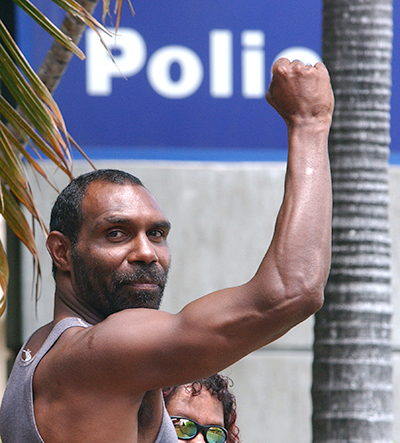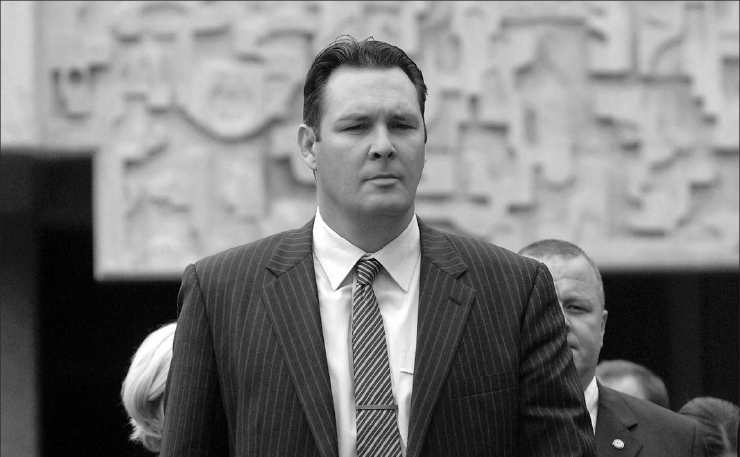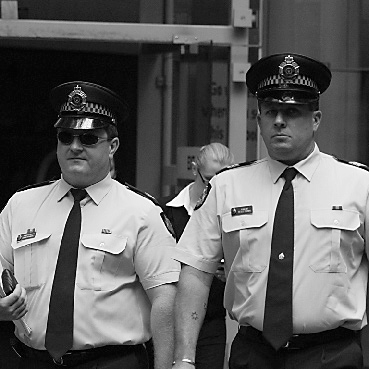 This special feature/analysis was first published in the National Indigenous Times newspaper on October 30, 2008, shortly after the conviction of Lex Wotton on charges of riotous conduct, and before his sentencing. Mr Wotton led an uprising against Queensland Police on Palm Island over the death-in-custody of an Aboriginal man, Mulrunji Doomadgee, in 2004. Written by New Matilda editor Chris Graham, it explores the differences between the treatment meted out to Aboriginal people responding to the death and an attempted cover-up, and that received by multiple Queensland Police found to have acted corruptly and/or illegally. The story is being re-published by New Matilda in the lead-up to the Voice referendum on October 14 to help readers form a better historical understanding of the brutality and injustice routinely suffered by First Nations people, and how that might influence demands for a more effective way to be heard by government.
This special feature/analysis was first published in the National Indigenous Times newspaper on October 30, 2008, shortly after the conviction of Lex Wotton on charges of riotous conduct, and before his sentencing. Mr Wotton led an uprising against Queensland Police on Palm Island over the death-in-custody of an Aboriginal man, Mulrunji Doomadgee, in 2004. Written by New Matilda editor Chris Graham, it explores the differences between the treatment meted out to Aboriginal people responding to the death and an attempted cover-up, and that received by multiple Queensland Police found to have acted corruptly and/or illegally. The story is being re-published by New Matilda in the lead-up to the Voice referendum on October 14 to help readers form a better historical understanding of the brutality and injustice routinely suffered by First Nations people, and how that might influence demands for a more effective way to be heard by government.
If you don’t laugh, you cry, right? So here’s an old Queensland joke that seems to have plenty of relevance today.
Blackfella 1: Hey Jimmy, did you see that Billy Smith died?
Blackfella 2: Died? I didn’t even know he’d been arrested.
Now here’s another question the state of Queensland should be asking itself today. It’s not as funny. Is Lex Wotton a danger to society?
The answer is simple. If Queensland Police stop killing black men in custody, and trying to cover it up, then Lex Wotton is no threat to anyone.

Not that it matters much. Late on Friday, Wotton was convicted of the offence of ‘rioting with destruction’ following the November 2004 uprising on Palm Island. He is now in custody, awaiting sentencing on November 7 in Townsville District Court.
The date would be familiar to many Aboriginal people, particularly Brisbane Murris. It represents 15 years to the day since Daniel Yock, a young Aboriginal dancer, died in police custody after a chase through the streets of West End. The more things change, eh?
The scale of the Palm Island injustice is hard to comprehend, and even harder to describe. So I won’t even try. I’ll just stick to the facts – the black and white of the issue. Specifically, how did the ‘blacks’ fare in the issue, over the ‘whites’?
First, to matters of criminality.
Lex Wotton has been convicted of inciting a crowd to move against police. It’s worth noting there was also substantial evidence presented at Lex Wotton’s trial – mostly by police – that Wotton ordered rioters to stop throwing rocks at officers and he secured transport (which was declined) to get police off the island safely. There was also video footage of Wotton trying to stop rioters from preventing a fire truck accessing the carnage.
Now here’s what the ‘whites’ did, but got away with.
On May 19, 2004, precisely six months before the killing – Snr Sgt Chris Hurley ran over an Aboriginal woman, Barbara Pilot, in a police vehicle. He was responding to a report of a domestic disturbance at a Palm Island home.
After striking Ms Pilot, Hurley declined to stop to render first aid. Instead, he opened his car door, looked at Ms Pilot lying on the ground, decided she was unhurt, and drove off.
Remarkably, Constable Kylie Fuller – the junior officer in the car with Hurley – reached the same conclusion. She then lied to the 2006 inquest into Mulrunji’s death, claiming that by the time Ms Pilot got to the police car, it had stopped.
Hurley reported the incident to his superiors, falsely claiming that the local doctor had assured him it was “highly unlikely” that Ms Pilot had been run over. He then returned to the area later that night and began approaching witnesses to determine what they’d seen.
Hurley needn’t have bothered with his own cover-up. Senior police in Townsville appointed a friend (and neighbour) of Hurley’s – Detective Senior Constable Darren Robinson – to investigate the matter. Over the following month, Robinson made precisely zero inquiries into the matter.

When he finally delivered his report to his superiors on September 1, 2004 – just two months before Hurley would beat Mulrunji Doomadgee to death, and almost four months after he’d run over Ms Pilot), Robinson cleared his mate Hurley of any wrong-doing.
The entire complaint, Robinson found, was fictitious. Barbara Pilot was faking it.
What Robinson neglected to mention in his report was that he had not interviewed any witnesses to the incident, nor had he included any medical evidence of Ms Pilot’s injuries.
Robinson’s first report was deemed inadequate and sent back to him by his superiors. That might have had something to do with the fact that Barbara Pilot had suffered a compound fracture to her leg during the incident, and that her shinbone was sticking out through her skin.
Robinson submitted a second report. It also contained lies, and he finally admitted on the stand during the trial of Lex Wotton trial that he had, indeed, lied to his superiors.
It subsequently also emerged that Robinson lied to the coroner’s inquest into Mulrunji’s death. During his evidence about the Barbara Pilot assault, Robinson testified to the coroner that he’d formed the view the incident never happened after speaking to “ …Senior Sergeant Hurley, Constable Kylie Fuller… the… the other witnesses who were mentioned in the occurrence sheet. No other person had information to give to me that the vehicle was responsible for it.”
This statement is a bald-faced lie. In his first report to superiors, Robinson falsely described the witnesses as “unidentified males”. In the second report, he falsely claimed they could not be located.
During Lex Wotton’s trial, Det Sgt Robinson finally admitted that although he knew the identity of both independent witnesses (because they were written in the occurrence sheet), he made no attempt whatsoever to speak to them.
There is credible evidence before the coroner’s court that the statements of Hurley and Fuller, both to their superiors and in the coroner’s court, should be further examined. The coroner in the Doomadgee case noted in her final report: “Hurley could have acknowledged that an accident had occurred, but decided to admit nothing. His attitude at that time appears to raise close parallels with how he dealt with the present matter. His first action was to attempt to persuade the treating doctor that the injury did not occur in the manner complained of. Concerned by the doctor’s unwillingness to agree with him, Hurley then set about ensuring that he and Constable Fuller were going to present a united front.”
It’s also worth noting that right up until the coronial inquest into the death of Mulrunji, Hurley maintained that he never ran over Barbara Pilot. However, he later accepted that he couldn’t exclude the possibility “100 per cent”. It’s a familiar line. And lie. After maintaining for several years that he never fell on Mulrunji, Hurley eventually accepted that he possibly did, after all, land on Mulrunji during their scuffle.
A history of violence
In addition to the Pilot incident, the trial of Lex Wotton heard that in September 2004 – four months after running over Barbara Pilot (and while Robinson was still conducting his ‘investigation’) – Hurley assaulted another Aboriginal man, Douglas Clay, in the Palm Island police station. About half a dozen police – including Hurley’s mate Robinson – witnessed the incident.
Of course, Hurley and senior Queensland police denied an assault had occurred, but after the death of Mulrunji, the Crime & Misconduct Commission investigated. They found traces of Mr Clay’s blood in the police cell where he was beaten.
Two months later, on November 19, 2004, Hurley beat Mulrunji to death on the floor of the police watchhouse.
It’s one thing to cover-up running over an Aboriginal woman. It’s another thing altogether to cover-up the beating death of a man in a police station. Obviously, a new investigation into Hurley’s alleged violence had to be opened.
So despite having directed Robinson only one month earlier to rewrite his ‘inadequate report’ that falsely cleared Hurley of running over Barbara Pilot, senior police from Townsville once again appointed Robinson to investigate his mate.
Within hours that investigation had been, in the words of the state coroner, seriously compromised.
Robinson and at least one other investigating officer – Detective Inspector Warren Webber – ate dinner and drank beers with Hurley that night.
Webber was the senior officer who appointed Robinson to the investigation. He was also a member of the special ‘Ethical Standards Command’, a unit set up specifically to ensure the highest standard of conduct by Queensland Police.
It was Webber’s job to oversee the investigation into Hurley and ensure it was conducted appropriately. Instead, Webber was drinking and dining with the accused before the body of the victim, Mulrunji, had even properly cooled in the local morgue.
A few days later, detectives provided an interim report to the coroner’s office. They chose not to disclose that an Aboriginal witness had seen Hurley assaulting Mulrunji on the floor of the police station.
The pathologist’s report subsequently found Mulrunji had died as the result of a simple “fall”, after tripping up a single step and landing on a flat floor.
It was quite some fall – Mulrunji’s injuries, which included a ruptured spleen and a liver that had been all but cleaved in two – were consistent with the sort of trauma you might see from a plane crash.
The Aboriginal witness who saw Hurley attacking Mulrunji was Roy Bramwell. He told a public meeting on Palm Island on November 23 what he’d seen. Two days later, despite all the turmoil, Bramwell was arrested by police over a domestic violence incident that had allegedly occurred the previous week.
The arresting officer? Detective Senior Constable Darren Robinson, the same cop who took four months to fraudulently investigate and falsely clear Hurley over his assault on Barbara Pilot. Indeed, the same cop who was supposed to be busy investigating Hurley over the beating death of Mulrunji.
How about the harm?

So that’s some of the criminality of the ‘whites’. It gets even more lopsided when you compare the injuries between Aboriginal residents of Palm Island, and Queensland Police, many of whom hid in a garage as the uprising kicked off.
Senior Sergeant Darren Randall, one of the police officers who testified in Lex Wotton’s trial, is quoted in The Australian newspaper claiming police nearly died in the riot:
“I felt abandoned to a certain extent by a lot of members of the public. I felt all my life I have dedicated myself to helping people and, with all that controversy, no-one appreciated me; Darren Randall was on that island and he nearly died.”
It’s certainly a dramatic claim, but let’s have a look at the extent of the actual injuries suffered by all parties.
First, the injuries sustained by Palm Islanders in the days and months immediately surrounding the death in custody and the uprising:
- Mulrunji Doomadgee was beaten to death. He suffered four broken ribs, a ruptured spleen, a torn portal vein and his liver was “almost cleaved in two” (it was held together by a couple of blood vessels).
- Three days before the August 2006 resumption of the inquest into his death, Mulrunji’s only son, Eric, hung himself on Palm Island.
- Patrick Nugent (aka Bramwell), the man who lay in the cell next to Mulrunji and comforted him as he died, also took his own life. It was one day before officials arrived on the island to review the decision of the Queensland DPP not to charge Chris Hurley over the death in custody.
- In the course of his arrest, Lex Wotton was tasered in front of his children by heavily armed police clad in balaclavas. The lead arresting officer was none other than Senior Constable Darren Robinson.
- A second Aboriginal man was also tasered by police in the raids that followed the riot.
- Barbara Pilot suffered a compound fracture to her leg after being run over by Chris Hurley.
- Douglas Clay – also assaulted by Hurley – suffered minor cuts and abrasions.
- Dozens of terrified children and adults were held at gunpoint by heavily-armed, balaclava-clad police in dawn raids that followed the uprising.
Now here’s the extent of the injuries suffered by police over the same period of time.
One officer – Sgt Peter Thomas – was hit in the hip with a rock. He suffered bruising. A second officer was reportedly hit in the chest or stomach with a rock. It’s unclear if he also sustained bruising.
That’s it.
Away from the glare of media, during his evidence to the court Snr Sgt Darren Randall conceded he was uninjured during the uprising.
The wash-up
Chris Hurley, a white cop, was tried by a jury of his peers – an all-white jury, overseen by a white judge on a charge of manslaughter. He got off.
Lex Wotton – a black man – was not tried by a jury of his peers, rather he was also tried by an all-white jury, overseen by a white judge on a charge of rioting with destruction. While Lex Wotton awaits his sentencing, his family – wife Cecelia, and four children (two of whom are disabled) are without a father. Palm Island has lost another of its citizens, for a few years at least.
By contrast, police who lost property in the riot have been financially compensated. Numerous officers are today still receiving taxpayer-funded trauma counselling – indeed the court was told counsellors sat through the evidence of some police during Wotton’s trial.
Darren Robinson, the cop who repeatedly lied – both to his superiors and in court – to protect his mate, has been promoted to the rank of Detective Sergeant. [Ed’s note: Robinson ultimately left the police service, and now works as a lawyer based int he Whitsundays].
On Monday, the Queensland Police Service revealed that it would be presenting bravery medals to the police present on the island on the day of the uprising. Robinson will be one of them.
For his part, Chris Hurley has been paid more than $100,000 in compensation from the Queensland Government for losses he claims he incurred during the uprising. Hurley took an eight-month break from the police service – on full pay – while awaiting his manslaughter trial (of which he was acquitted). He has since returned to the job on the Gold Coast, and was promoted to the rank of Inspector. [Ed’s note: Hurley was eventually convicted of multiple crimes, including assaulting a female colleague; dangerous driving after a police pursuit in which he rammed a vehicle, then illegally fired shots at its occupants; and assaulting a motorist in 2013 after he mistakenly believed the driver yelled an insult at him. For that crime, Hurley managed to have his sentence reduced (from two ‘convictions recorded’ to ‘offences proved but no convictions recorded’) by claiming he was suffering from Post Traumatic Stress Disorder at the time. The source of his PTSD, the court was told, was “the ordeal he endured on Palm Island”. Notably, Hurley wasn’t on Palm Island during the uprising – he’d already been removed. So the ‘ordeal’ Hurley was actually referring to was what flowed from beating an Aboriginal man to death on the police station floor, lying about it, and then participating in a cover-up. After his convictions, Hurley was allowed to resign from the Queensland Police Service on the grounds he was medically unfit, thereby preserving his pension. This is despite the fact he’d already been forced to repay more than $30,000 in compensation after receiving an insurance payout for property lost during the Palm Island uprising, but also receiving the $100,000 ex-gratia payment from the Queensland Government].
By contrast, 28 Aboriginal people were arrested and charged over the death in custody and uprising. For his part, Lex Wotton is facing life in prison, the very same sentence delivered to Mulrunji’s family. [Ed’s note: Mr Wotton was ultimately sentenced to seven years jail, with a minimum of two years, which is what he served. In happier news, Mr Wotton, his wife Cecilia and mother Agnes successfully sued the Queensland Government in the Federal Court on the grounds of Racial Discrimination, opening the door to a class action from 447 Palm Islanders, which led to a $30 million settlement and a formal apology from the Queensland Government.]
Donate To New Matilda
New Matilda is a small, independent media outlet. We survive through reader contributions, and never losing a lawsuit. If you got something from this article, giving something back helps us to continue speaking truth to power. Every little bit counts.




